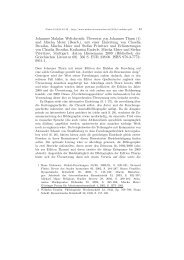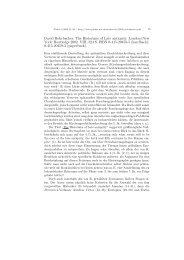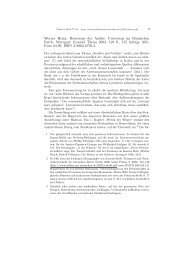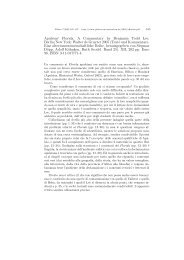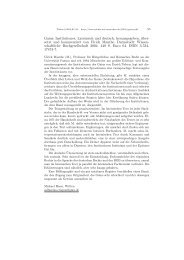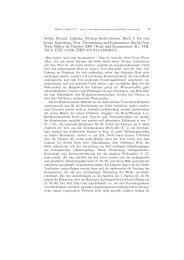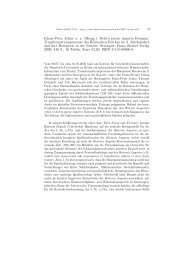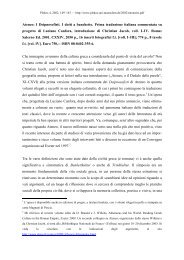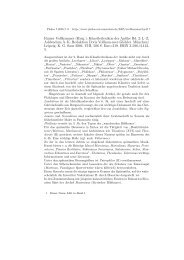Charlotte Lerouge: L'image des Parthes dans le monde gréco - Plekos
Charlotte Lerouge: L'image des Parthes dans le monde gréco - Plekos
Charlotte Lerouge: L'image des Parthes dans le monde gréco - Plekos
Create successful ePaper yourself
Turn your PDF publications into a flip-book with our unique Google optimized e-Paper software.
P<strong>le</strong>kos 11,2009,33–36 – http://www.p<strong>le</strong>kos.uni-muenchen.de/2009/r-<strong>le</strong>rouge.pdf 33<br />
<strong>Charlotte</strong> <strong>Lerouge</strong>: L’image <strong>des</strong> <strong>Parthes</strong> <strong>dans</strong> <strong>le</strong> <strong>monde</strong> grécoromain.<br />
Du début du I er sièc<strong>le</strong> av. J.-C. jusqu’à la fin du Haut-<br />
Empire romain. Stuttgart: Franz Steiner Verlag 2007 (Oriens et<br />
Occidens 17). 427 pp. EUR 62.00. ISBN 978-3-515-08530-4.<br />
In her book, <strong>Charlotte</strong> <strong>Lerouge</strong> tack<strong>le</strong>d the picture of the Parthians as is existed<br />
in the literature of Rome beginning from its first contacts with the Arsacid<br />
state in the 90’s BC until the end of the Parthian empire (224 AD). Among<br />
the most comprehensive monographs of the Parthians to have been published<br />
recently, and certainly the largest in French historiography of Parthian Iran,<br />
the book consists of two main parts. The first discusses generalized imagery of<br />
the Parthians in Rome and relations between the two (pp. 43–169), and part<br />
two projects an “ethnographic image” of the Parthians (pp. 173–360). Between<br />
them, the parts comprise nine chapters with these further divided into many<br />
subchapters. It must be said that the subject <strong>Lerouge</strong> chose is no terra incognita<br />
in ancient studies. 1<br />
Part one first analyzes contacts between the Parthians and Rome under<br />
Sulla, Lucullus, and Pompeius, and tries to decide whether the Romans well<br />
understood the extent of Parthian power. <strong>Lerouge</strong> accepts the date 92 BC for<br />
Sulla’s meeting with the Parthians (p. 43). More likely dating seems to be 94<br />
or possibly 93 BC. 2 <strong>Lerouge</strong> wonders if Sulla concluded a formal treaty and<br />
maintains that the Parthians remained neutral in Eupator’s war against Rome,<br />
which if fact is dubious (p. 46, n. 14). Whi<strong>le</strong> this is not a widely accepted view<br />
in scholarship, it seems that Parthia at the time actively supported Mithradates<br />
VI Eupator, whi<strong>le</strong> Tigranes, Pontus’ chief ally, was a loyal vassal of the<br />
Arsacids until ca. 80 BC. Through Tigranes, the Parthians under Mithradates<br />
II (123–87) intervened in the conflict between Pontus and Rome with an<br />
eye on their own sphere of influence in Commagene and Syria. 3 Considering the<br />
1 There already are in existence fundamental works on both chief aspects, i. e.,<br />
political history (cf. J. Wolski: L’Empire <strong>des</strong> Arsaci<strong>des</strong>. Acta Iranica 32, Lovanii<br />
1993; K. H. Zieg<strong>le</strong>r: Die Beziehungen zwischen Rom und dem Partherreich.<br />
Wiesbaden 1964) and ethnographic understanding of Parthia (the excel<strong>le</strong>nt work<br />
by H. Sonnabend: Fremdenbild und Politik. Frankfurt 1986).<br />
2 Cf. S. Dmitriev: Cappadocian Dynastic Rearrangements on the Eve of the First<br />
Mithridatic War. Historia 55, 2006, 285–297; M. J. Olbrycht: Mithradates VI<br />
Eupator and Iran, in: J. M. Hœjte (ed.): Mithridates VI Eupator and the Pontic<br />
kingdom. Aarhus 2009, forthcoming).<br />
3 See M. J. Olbrycht: Bosporos, the Steppe Peop<strong>le</strong>s of the Black Sea Area and<br />
Parthian Iran in the Grand Strategy of Mithradates VI Eupator, in: V. N. Zinko<br />
(ed.): Bospor Kimmeriyskiy i varvarskiy mir v period antichnosti i srednevekov’ya.<br />
Militaria. Kerch 2008, 324–325).
34 Marek Jan Olbrycht<br />
political situation in Anatolia, Syria, and Transcaucasia in the 90’s–80’s BC,<br />
more attention should be given to the Arsacids’ political aims.<br />
The next two chapters show Roman relations with Parthia from the batt<strong>le</strong><br />
of Carrhae till the time of Augustus (pp. 83–128). <strong>Lerouge</strong> supplies a brief characteristic<br />
of political relations and the Roman ideology which had become fully<br />
formed under Augustus, with the Parthians as a grand adversary playing a key<br />
ro<strong>le</strong> in it. They were seen as dangerous enemies whom, however, Augustus reputedly<br />
subdued through diplomacy. <strong>Lerouge</strong> rightly notes and appreciates the<br />
notions of equality between Rome and Parthia as two great powers, as expressed<br />
by several Augustus-time authors, including by Iust. 41, 1, 1 (pp. 119–123).<br />
Relatively litt<strong>le</strong> room is devoted to Roman-Parthian relations in the period<br />
14–224 AD, all compressed in just a sing<strong>le</strong> chapter (pp. 129–169). <strong>Lerouge</strong> rightly<br />
acknow<strong>le</strong>dges the importance of Armenia to both powers. In her assessment<br />
of Trajan’s actions, she accepts Roman propaganda too literally, treading within<br />
existing paradigms. And so, Parthamaspates’ coronation, feted in Roman<br />
propaganda, was in itself a defeat for Trajan, who had tried to organize the territories<br />
won from the Parthians into provinces, and not a vassal puppet state.<br />
For the king of the Parthians and for the Imperium Parthicum elites, the coronation<br />
itself carried litt<strong>le</strong> weight as the usurper could claim no backing from<br />
any major Parthian faction.<br />
The second part of the book supplies not only, as the somewhat mis<strong>le</strong>ading<br />
tit<strong>le</strong> suggests, an ethnographic image of the Parthians, but also an analysis of<br />
important aspects of their history. These include the beginnings of the Arsacid<br />
state, geography and the empire’s territorial extent, political institutions,<br />
warfare, religion, and mores of the Parthians. Many of these issues, such as the<br />
Parthian empire’s borders and military matters, c<strong>le</strong>arly go beyond the declared<br />
“ethnographic image”.<br />
A valuab<strong>le</strong> discourse is offered for the names records applied to the Arsacid<br />
empire (pp. 196–198). The discussion of the eastern frontier (pp. 215–223)<br />
reveals certain conceptual shortcomings resulting in an erroneous treatment of<br />
Mithradates I’s (ca. 170–132 BC) eastern conquests. The re<strong>le</strong>vant information<br />
from Trogus/Iustinus and Diodoros about that king’s conquests reaching India<br />
is considered laudatory first, historical a distant second (pp. 219–220), as<br />
these authors are said to have simply tried to show a match for A<strong>le</strong>xander.<br />
Here, the <strong>des</strong>ire to study a “picture of the Parthians” visibly biased a sober<br />
assessment of their historical attainments. In speaking about Mithradates I’s<br />
eastern conquests, <strong>Lerouge</strong> should have cited such key sources as Orosius 5, 4, 16<br />
and Strabo 11, 9, 2. <strong>Lerouge</strong> devotes much thought to fairy-ta<strong>le</strong> Roman visions<br />
of the east and their dreams of conquest all the way to India (pp. 221–223). By<br />
and large, then, <strong>Lerouge</strong> does not treat the Parthian conquest of Bactria and<br />
adjacent lands as historical fact. Mithradates I’s operations reaching India are
<strong>Charlotte</strong> <strong>Lerouge</strong>: L’image <strong>des</strong> <strong>Parthes</strong> <strong>dans</strong> <strong>le</strong> <strong>monde</strong> gréco-romain 35<br />
not figment of the imagination. 4 The analysis of information on Parthia’s eastern<br />
fringes virtually ignores Apollodoros of Artemita, who merits only marginal<br />
mention (p. 218, n. 125) and is absent from the index of authors.<br />
<strong>Lerouge</strong> <strong>des</strong>cribes in detail the land of Parthyene (pp. 226–244). Like A.<br />
Kuhrt and S. Sherwin-White 5 she believes that originally the Parthian state<br />
was limited to lands north of Kopet Dagh (pp. 228–229), which is wrong if<br />
Polyb. 10, 28–31 is to be believed. A discussion of a strictly geographically<br />
and politically understood Parthia/Parthyene would require a closer study of<br />
sources for A<strong>le</strong>xander’s era. Already by then, Parthia/Parthyene as a province<br />
of north-eastern Iran had expanded to include lands as far as the Caspian Gates<br />
in the west. This is not an extent only achieved by the Arsacids, as <strong>Lerouge</strong><br />
would have us believe (pp. 230–231).<br />
Honest coverage is given to Parthian political institutions. The author analyzes<br />
a passage by Poseidonios apud Strab. 11, 9, 3 on how the Parthians e<strong>le</strong>cted<br />
a king. The passage speaks of a dual senate existing. In this reference, the<br />
meaning of the verb καθιστάναι (pp. 245–255) is disputed. <strong>Lerouge</strong> correctly<br />
conclu<strong>des</strong> that the account does not suggest that the Parthian monarchy was<br />
e<strong>le</strong>ctive but rather that the senate played an advisory ro<strong>le</strong> (p. 250). <strong>Lerouge</strong><br />
rejects Wolski’s hypothesis that the term βασίλειοι could refer to governors<br />
(p. 250, n. 15). Here, however, it would be worth citing Plinius 6, 112 and his<br />
phrase about 18 kingdoms (regna) in Parthia. The author points to the considerab<strong>le</strong><br />
importance of priests (μάγοι) under the Arsacids (pp. 254 f.), but their<br />
status certainly was not as e<strong>le</strong>vated as under the Sasanians.<br />
<strong>Lerouge</strong> offers a detai<strong>le</strong>d discussion of the Arsacids’ royal banquets as <strong>des</strong>cribed<br />
by Poseidonios. She rightly points to similarities between Poseidonios’<br />
account and the re<strong>le</strong>vant fragment by Herak<strong>le</strong>i<strong>des</strong> on 4 th -century Persia<br />
(p. 257). Furthermore, she cites Tang-e Sarvak and Hatra reliefs as material<br />
useful for her analysis (p. 258). Poseidonios relates the original custom of<br />
the Parthian king tossing bits of food among courtiers. A similar practice was<br />
observed among Thracians by Xenophon (Anab. 7, 3, 21). <strong>Lerouge</strong> sees Poseidonios’<br />
<strong>des</strong>criptions as an illustration of Parthian <strong>des</strong>potism (pp. 260–267).<br />
Much space is devoted to warfare (pp. 273–321). In studying respective<br />
wars of the Parthians against the Se<strong>le</strong>ucids, <strong>Lerouge</strong> belitt<strong>le</strong>s the strugg<strong>le</strong>s<br />
under Se<strong>le</strong>ucos II (p. 274). In terms of Parthian armament and tactics, the<br />
chapter has litt<strong>le</strong> originality, but valuab<strong>le</strong> insights are offered on the overall<br />
character of the military and its perceptions by Roman authors. The author<br />
4 <strong>Lerouge</strong> fails to quote the seminal book by P. Daffinà: L’immigrazione dei Sakā<br />
nella Drangiana (ISMEO 9), Roma 1967. Another notab<strong>le</strong>, if not wholly successful<br />
publication is J. R. Gardiner-Garden: Apollodoros of Artemita and the<br />
Central Asian Skythians. Papers on Inner Asia, No. 3. Bloomington, Indiana<br />
1987, as it offers some interesting proposals.<br />
5 From Samarkhand to Sardis. London 1993.
36 Marek Jan Olbrycht<br />
points to Trogus/Iustinus’ accounts and tries to justify the opinion held by<br />
the ancients that Parthian warfare was Persian and Scythian in origin (pp.<br />
303–305). During the late Republic, the Romans thought highly of Parthian<br />
military prowess, especially after Carrhae and Pakoros’ invasion. Among Roman<br />
opinions (pp. 305–308), <strong>Lerouge</strong> rightly stresses not only the many voices<br />
of poets, but, more importantly, of dispassionate historians like Fronto, who<br />
said, olim adversus Romanos intentum et infestum et instructum, bellis exercitatus<br />
ac tam ab insidiis Romanorum (Princ. Hist. 9). Other views of Parthia<br />
were also persistent: In an instructive set of accounts, some Roman authors<br />
dismissed Parthians as unskil<strong>le</strong>d at hand-to-hand combat, poor at poliorcetics,<br />
perfidious, treacherous, and lacking perseverance (pp. 308–317). <strong>Lerouge</strong> makes<br />
an interesting comparison of accounts of two wars: the campaign of Ventidius<br />
in which he defeated the Parthians in 38 and the campaign of Antonius of 36<br />
BC. Both differ greatly in their <strong>des</strong>criptions of the Parthians, partly ref<strong>le</strong>cting<br />
the respective authors’ prejudices (pp. 310–313).<br />
In religious matters, valuab<strong>le</strong> remarks are offered about Mithra (pp. 327–<br />
330) which aptly point to the ceremony with Nero and Tiridates (66 AD) and<br />
to Parthian coins as an important source on beliefs. <strong>Lerouge</strong> discusses the possibility<br />
that Roman Mithraism derived from Parthia.<br />
In the summary, <strong>Lerouge</strong> notes that stereotypical notions about Parthians<br />
as known from Roman accounts largely continue Greek prejudices against the<br />
Achaemenid Persians (pp. 360 f.). In the end, the “ethnographic image” and<br />
“political image” prove inextricably bound up (p. 363). The work conclu<strong>des</strong><br />
with a comprehensive bibliography (pp. 365–390).<br />
The concept of the book seems not thoroughly thought out as both parts,<br />
political and ethnographic, intertwine throughout (such as in the military and<br />
in political institutions). At times, the reader is at a loss about whether the<br />
author is citing Roman notions or is trying to uncover historical truth.<br />
Despite its shortcomings, <strong>Lerouge</strong>’s book is a valuab<strong>le</strong> contribution to the<br />
study of Parthian history. The author has put in much effort into compiling<br />
sources and presenting views existing in scholarship. Often she contributes her<br />
own findings and valuab<strong>le</strong> remarks. What with the book being <strong>Lerouge</strong>’s scholarly<br />
debut, it <strong>des</strong>erves appreciation.<br />
Marek Jan Olbrycht, Rzeszów (Po<strong>le</strong>n)<br />
marekolbrycht@wp.pl<br />
Inhalt P<strong>le</strong>kos 11,2009 HTML<br />
Startseite P<strong>le</strong>kos





